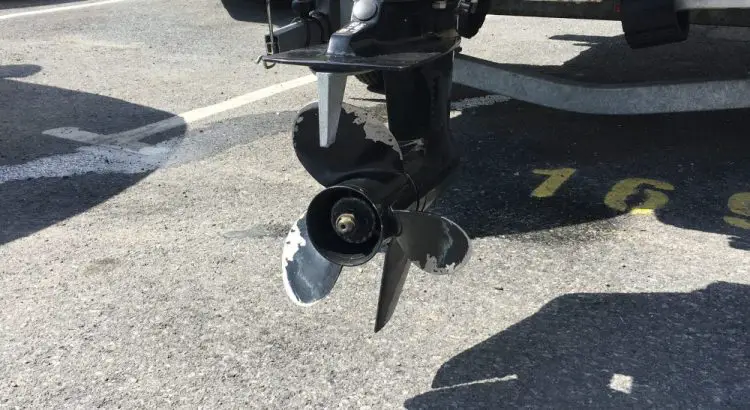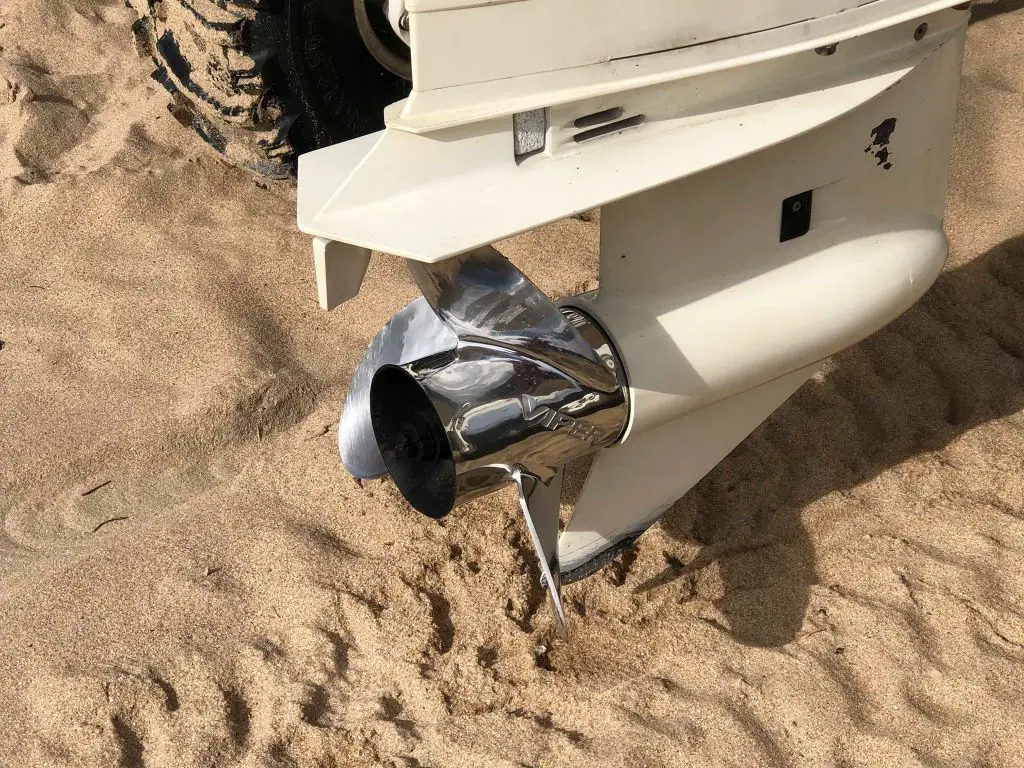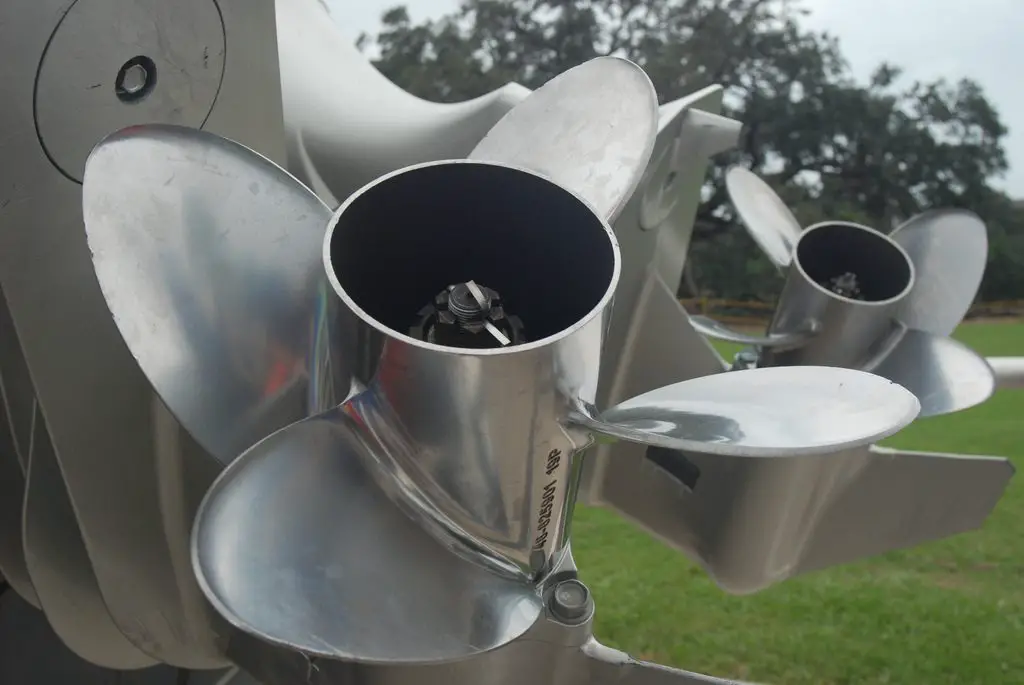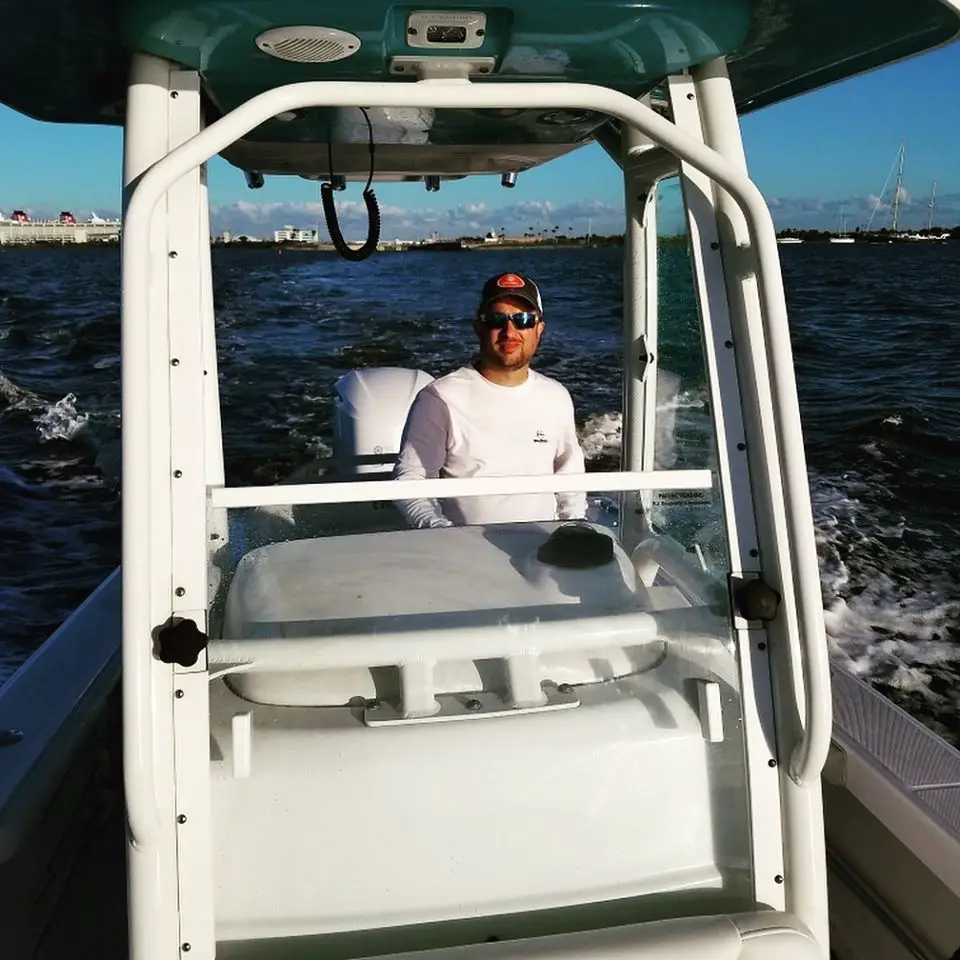This page contains affiliate links. This means that we may get a small commission for recommending products, if you choose to click on something and buy it. This does not cost you anything, but we wanted to be honest and let you know!
(Last Updated On: )To improve boat performance, choosing the correct boat propeller is an important decision.
The right boat propeller and style of the prop will keep the engine operating at the optimum RPM range for maximum horsepower on the water.
The best boat propeller is the Turning Point Hustler Aluminum, which will improve handling and boat lift to increase the overall performance of your boat on the waters.
It is important to note that with many propellers, you will need to purchase a hub system for the replacement propeller.
However, it is a worthwhile process as a propeller can transform your boat for more performance.
Table of Contents
Best Propeller For Outboard Motor
| Boat Propellers | Preview | Blades |
| Turning Point | 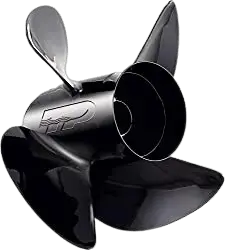 | 4 |
| Turning Point 31501931 | 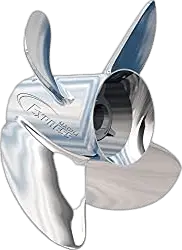 | 4 |
| Quicksilver Nemesis |  | 4 |
| Mercury Black Max 3 | 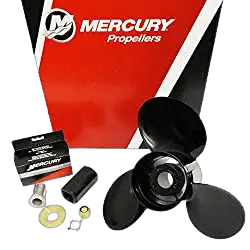 | 3 |
| MotorGuide Machette III | 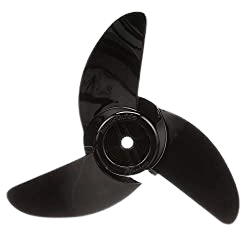 | 3 |
You should choose a top-rated boat propeller that is similar to the diameter and pitch of your current boat prop unless your current prop is unsatisfactory.
Simply switching materials i.e. change to stainless steel or using a 4 blade instead of a 3 blade prop can see big performance gains on the waters.
Not all propellers are the same because the size, number of blades and materials all make a difference to the way the boat handles and performs.
Optimizing your boat performance with the right propeller is one of the easiest modifications.
Below is a list of the best boat propellers to improve your boat performance with different sizes, materials, and blades.
Turning Point Hustler Aluminum Propeller
The 4 blade aluminum propeller by Turning Point comes in a range of sizes in order to be compatible with a range of boats.
An additional hub kit will be required for the installation of this propeller but the end result is guaranteed performance compared to OEM and other aftermarket propellers.
With the added blade, you will notice an improvement in handling and take-off speeds, which is great for those using inflatable towable tubes on the waters.
If you are currently using a 3 blade propeller and looking to upgrade for more speed and less fuel consumption, this is the one for you.
It is the best boat propeller for more speed on the waters and is relatively reasonably priced.
Turning Point Stainless 4-Blade Propeller
For those wanting the best performance and are not on a tight budget, Turning Point also offers a stainless steel 4 blade propeller.
It is made from 15-5 stainless steel that gets harder and stronger with age for long-lasting use.
This stainless steel boat propeller is tuned for performance with progressive pitch angles, aggressive rake and cupping, tuned vents and more.
This results in increased performance and fuel economy whilst minimizing slip.
Converting to the best stainless steel boat propeller such as the Turning Point will be a big improvement on the majority of boats.
It is not cheap by any means but adding maximum performance to the boat will require a large budget.
Quicksilver Nemesis Propeller
The Quicksilver Nemesis is a premium 4 blade aluminum propeller with the holding and acceleration of a 3 blade.
It is available in a large selection of diameters and pitches to be compatible with the majority of outboard motors.
The smaller diameter of the Quicksilver Nemesis allows the propeller to spin up quicker for increased acceleration.
For those with a 3 blade already, simply replace with the nemesis that has the same pitch as your current propeller.
Overall, it is the best boat propeller that focuses on adding much-needed performance to your boat.
Quicksilver claims to provide 16% to 25% faster acceleration by switching from an OEM to the Nemesis.
Mercury Black Max 3 Blade Prop Propeller
Mercury is a reputable boating brand known for high-quality products and the Max 3 Propeller is made using die-cast aluminum and equipped with the Flo-Torq II hub system.
It is a 3 blade design designed to fit Mercury/Mariner and other outboards.
For those looking for a direct replacement that adds more performance and its great value for money, the Max Blade 3 is the best buy.
It comes with the hub system and of course the propeller, which can all be installed in less than an hour.
Overall, it is the best 3 blade propeller for outboard motors and the aluminum is finished in an attractive phantom black to add to the premium look and feel.
MotorGuide Machette III Trolling Propeller
The Machette III by MotorGuide is a propeller for trolling motors that is ideal for shallow waters and weeds.
The design means there is less power compared to the others but compared to many other trolling propellers, it is speedy and efficient.
It is a 3.5-inch hub with a tapered hub design that performs well on 12, 24 and 36-volt motors.
The package comes with a prop, prop pin, and prop nut ready to install the propeller in a matter of minutes.
Overall, the MotorGuide Machette III is the best trolling motor propeller, which has excellent cutting abilities through weeds and works great in shallow water…
Boat Propeller Buying Guide
A brand new boat propeller can work wonders for improving your boat’s performance in terms of acceleration and handling but also fuel economy.
To cut through the waves more easily and without slipping all improves the efficiency and get the maximum from the outboard motor.
Propeller blades come in a range of designs, material constructions, number of blades and other factors.
Choosing the correct propeller that will make use of all the performance your outboard motor has is critical.
Below are some factors you should consider before purchasing one of the recommended propellers above.
Propeller Sizing
The prop size is determined by the diameter and pitch where the smaller diameter props are associated with the smaller outboard motors and vice versa.
The pitch is the forward movement of a boat propeller during one complete RPM.
In terms of the pitch, if you have a lower pitch, it will have an increase in acceleration and pulling power whereas a higher pitch will go much faster.
However, in a higher pitch, the engine must have enough power to keep the RPM range at the optimum range.
Number of Blades
In general, the most common number of blades is 2, 3 and 4 with 2 blades only really associated with trolling motors.
3 and 4 blades are usually interchangeable and have their own advantages.
Boat Propeller Construction
The most common material used in the majority of boats is composite, aluminum and stainless steel.
Composite is the least expensive and offers good performance but once they are damaged, its near impossible to repair.
Aluminum is the most popular as its a great all-rounder and suits a wide of applications with a large array of designs.
Stainless steel is the best material for propellers as it offers the best in terms of performance and durability but it is the most expensive material used in the construction of propellers.
Boat Propeller Maintenance
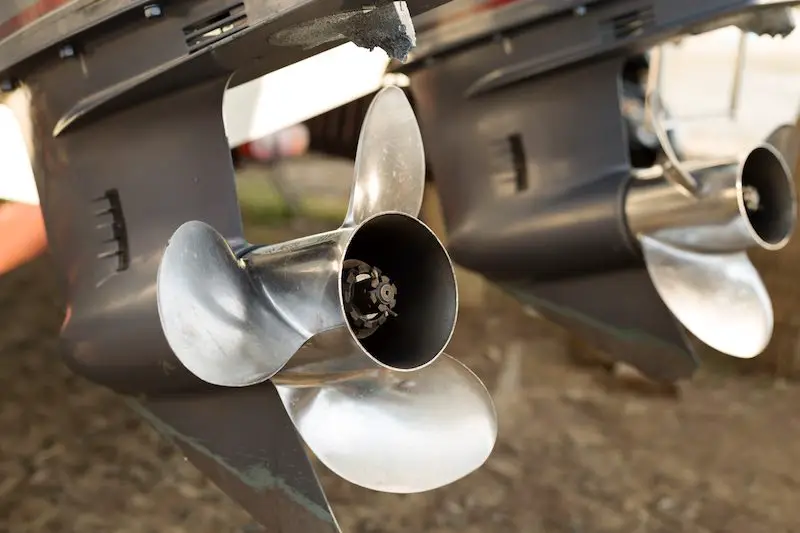
If you had wanted a raft, you would have bought one. Unfortunately, if your propeller is not correctly maintained, your boat could become one.
Keeping your propeller properly maintained will keep your boat moving efficiently and will give you a rewarding performance in the water.
If you maintain your propeller on a regular schedule and catch damages early, it will go a long way towards keeping it running smoothly and lasting a long time.
Maintaining your propeller is essential for safety and will give you better gas mileage and get you back to the dock.
While you might think of propellers “propelling” your boat through the water, they can also cause drag.
The propeller on your boat works by creating lower pressure on the front of the blades than on the back.
If the blades have dings, nicks, or scratches, they will not work at their best, and you will not get the optimum performance out of your engine.
Make a Visual Inspection
Looking at the propeller will let you know if there is any external damage. Make sure to inspect it before you head out on the water.
The best practice is to get in the habit of inspecting the propeller when coming back in. It will save having any surprises or last-minute repairs before you go out the next time.
During the visual inspection, you will be looking for dings, nicks, scratches, or dents. If these damages are not too deep or broad, it will be a minor repair.
If you knowhow, you could fix the blades yourself by filing or filling the damages. Keep the blades properly balanced because if the blades are uneven in weight, it will affect the overall performance.
As best you can, try not to hit rocks, gravel, sandbars, or other objects in the water. These items could bend the blades on the propeller.
If the blade does get bent, it is best to take it to a repair shop to get it back in working condition.
Maintenance
If you do see areas that need repair, it is best to remove the propeller from the prop shaft. It is easy to work on the propeller and to clean it when it is off the shaft.
Once the propeller is off, check out the prop shaft and seal. You will probably have to wipe off the grease to be able to get a good look at it.
Check the seal for wear. The seal will keep water from getting into the gearcase. Water has to be kept out of the gearcase, or the motor won’t run correctly.
A common cause of damage to the seal is the caught-up fishing line. Be sure to look it over carefully as the line can be hard to see.
The way to check to see if there is any water in the lower unit is by draining a small amount of the unit’s lube into a jar.
If it looks to you that like the lube is milky, that means that water is present.
If this is the case, you should have a professional take a look at the propeller before you use it again.
If you don’t see evidence of water, reapply grease to the prop shaft. After reapplying the grease, you can reinstall the propeller.
Check to make sure that the nut is tight and use a new cotter pin when you are keeping it in place.
While the propeller is off, it is an excellent time to clean and repaint or polish it.
If you use your boat in saltwater, don’t skip rinsing your propeller off with fresh water after time out in the water as saltwater can cause oxidation.
Damaged Blades
If there is significant damage to the propeller, it is easy to see.
If you know that you have hit something, or if you need to go through sandbars frequently, you will want to check your propeller more often.
If you don’t feel that your boat is running smoothly, damage to your blades might be the cause.
The damage can impair the fuel efficiency of your boat and put additional stress on other parts of the engine.
If there is substantial damage to the propeller blades, it is best not to delay having the repair done, and it will need to be done by a professional.
Cracks
Cracks, even small ones, can expand and result in a bigger problem. Even hairline cracks can turn into an issue that leaves you stranded.
Like most everything else, the sooner you catch the crack, the easier it is to repair.
If your propeller is stainless steel, it is heat-treated and has greater strength and durability.
Small nicks can be filed to smooth them down, which will prevent them from getting worse.
Just make sure that you don’t grind off so much that it causes the blades to be imbalanced.
Wear And Tear
If you see significant wear on your propeller, even if the wear is even, the propeller might need replacing.
Missing paint, sharpened or pointed blades and blunt edges on the leading sides can be an indication of wear.
The shortened diameter will cause higher RPM and less efficiency.
If there is enough base material, a competent repair shop can build the blades back up to the original measurements.
Corrosion
Saltwater can corrode propellers and cause them to appear pitted. The corrosion can put holes in the blades and render them useless.
Aluminum and bronze alloy propellers are more prone to corrosion, but stainless steel can also feel the effects of saltwater.
If there is significant pitting, the propeller will need replacing.
When Should You Replace Your Boat Propeller?
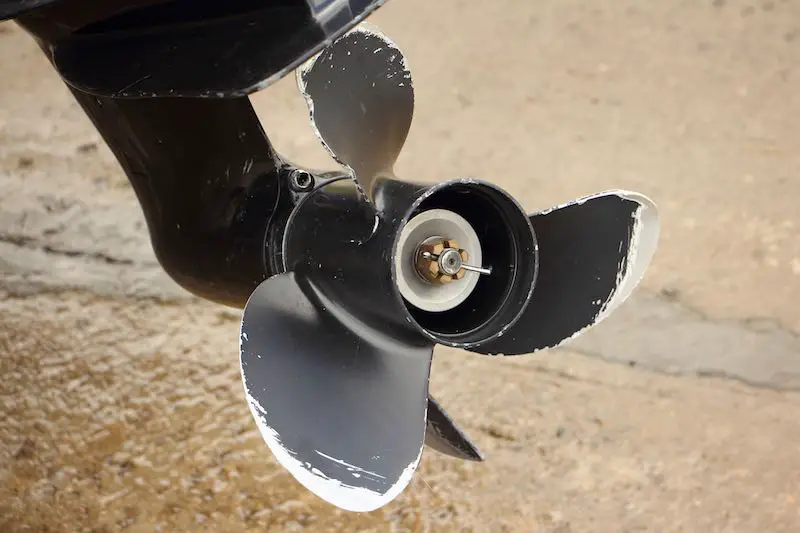
It can sometimes be hard to know when you need to replace a propeller, especially if you can’t see any real evidence of damage.
Here are a few things to watch for that might be an indication that your propeller needs repair or replacement.
Decreased fuel efficiency
Your propeller has a significant impact on your boat’s fuel efficiency.
A propeller that is damaged can cause you to waste fuel and will cost you more money in frequent refueling.
If you notice that you are using more fuel than usual, the propeller might be the reason why if the propeller has too much pitch.
If the pitch needs to be adjusted, that is going to be a trip to the repair shop.
You have hit an object with the propeller
If you can avoid it, try not hitting rocks or going through sandbars. It can spell disaster for your propeller.
Once a blade is bent out of shape, your engine will be compromised.
The imbalance can damage internal parts of the engine and the transmission.
Once you have struck an object, examine the propeller as soon as possible. Do a visual inspection.
Even if you don’t see the damage, but know you took a good hit, take the propeller off and have a repair shop give it the once over.
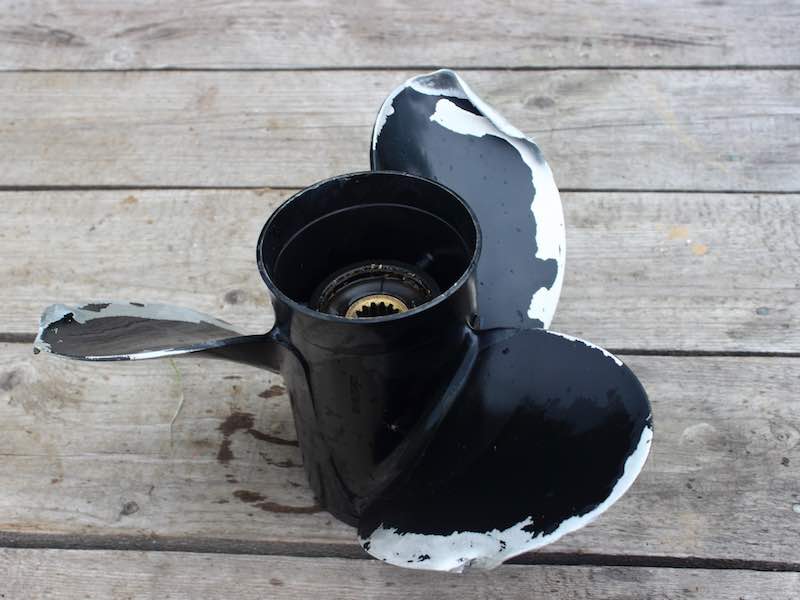
If it comes down to replacing your propeller, think about the type you want to replace it with.
Aluminum is the most common and least expensive material. It is a softer alloy and tends to flex at high speeds, which makes it less effective at pushing against the water.
Even so, it is suitable for most outboard motors and is extensively used.
Stainless Steel propellers have stiffer, thinner blades and cuts through the water more effectively. While it will cost more than aluminum, it is about five times more durable.
Both Stainless and aluminum propellers can be repaired. However, stainless can be repaired to a like-new condition where aluminum will eventually suffer from metal fatigue and lose its strength.
An aluminum propeller, depending on if it is a three or four-blade prop, will cost you between one and two hundred dollars.
A stainless steel propeller will start at about $350 and go up from there. It is a steep price at the onset, but will last longer and will accept repairs better than aluminum.
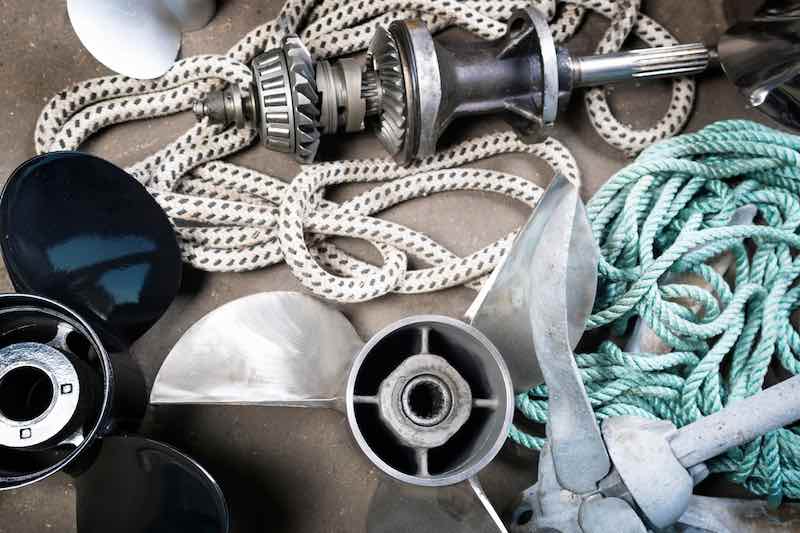
Pitch
The propeller size is expressed in two numbers. One is diameter, and one is pitch. Diameter is always stated first.
Diameter is the number that is always stated first, and the diameter is two times the distance from the center of the hup to the tip of any blade.
Generally, smaller prop diameters go with smaller engines or with fast, high-performance boats.
Pitch is the theoretical forward distance, in inches, that a propeller travels in one revolution.
It is a theoretical distance as there is always some “slip” between the propeller and the water of about 10% to 15%. That means that the actual distance traveled is less than the theoretical value.
Think of pitch as speed, or as the gear selection on a car’s transmission.
The RPMs of your engine and of the pitch are inversely related.
If you increase the pitch, it will decrease the engine RPMs. If you decrease the pitch, it will increase the engine RPMs.
The rule of thumb is that a two-inch increase in pitch will result in a reduction of 300 to 400 RPMs.
On the other hand, a two-inch decrease in pitch will result in an increase of 200 to 400 RPMs.
If your engine is under revving, you might want a propeller with less pitch. If your engine is over-revving, you should choose a propeller with more pitch.
How to Install a Boat Propeller?
Conclusion
As with any boat owner, you want to be able to spend hours out on the water, enjoying life and your boat.
By checking our propeller regularly and repairing or replacing your propeller as needed, you will achieve that goal.
The last thing you want is to be on a “raft” that you have to figure out how to get to shore. Much better to spend the time in preventive maintenance and reap the rewards out on the water.
Upgrading your propeller is the perfect way to optimize your performance but it can’t also do more harm than good if you choose the wrong one.
As a rule of thumb, try to keep to a similar pitch as your OEM setup but improve the propeller material or number of blades for quick wins in terms of performance.
